- 17 Jun 2024
- 9 Minutes to read
-
PDF
Validate Addresses
- Updated on 17 Jun 2024
- 9 Minutes to read
-
PDF
Overview
Verify the validity of mailing addresses and standardize records according to the USPS format. This process ensures cleaner data and helps identify duplicates when matching on address fields. It is also useful for customers that use physical mailers to a client base, decreasing unnecessary mailing costs and ensuring accurate delivery. To use this feature, tokens must be purchased, which are offered at an affordable low cost.
Navigation
Purchase Credits/Tokens
- Choose the ‘Subscription’ → ‘Data Services’ option from the top-right navigation options to purchase credits.
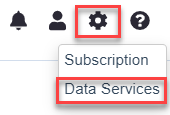
Validate Addresses
- Choose the ‘Tools’ → ‘Validate Addresses’ option from the left-hand-side navigation window.
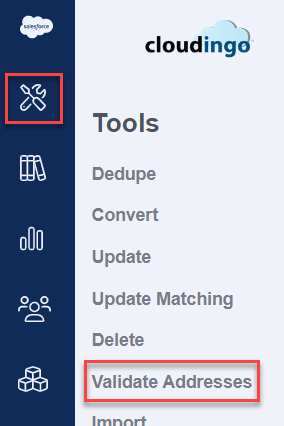
- Tabs at the top of the page separate the indexed objects. Choose 'All' to view all indexed and non-indexed object filters.

- Choose ‘Create New Job’ to build a new filter.
- Choose ‘Edit’ from a specific filter’s menu option to edit an existing filter.
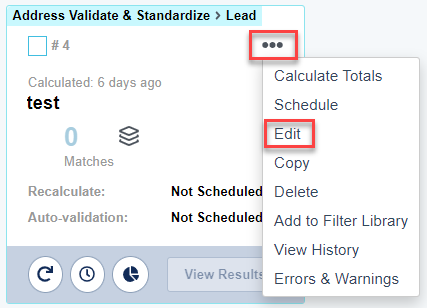
Actions & View Options
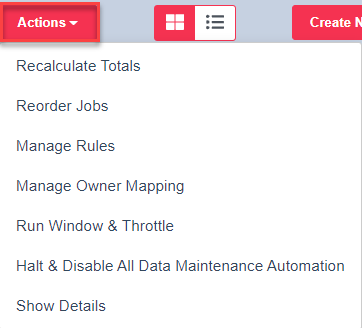
- The 'Actions' menu provides a variety of options.
- Recalculate Totals: Recalculates (queries) all filters at one time.
- Reorder Jobs: Choose this option to reorder the filters for display.
- Manage Rules: Choose this option to get directly into the Manage Rules page.
- Manage Owner Mapping: Choose this option to get directly into the Owner Mapping page.
- Run Window & Throttle: Choose this option to get directly into the Run Window & Throttle page.
- Halt & Disable All Data Maintenance Automation: Choose this option to temporarily stop all currently running or future automation jobs.
- Jobs currently running can take time to completely stop.
- Show Details: Choose this option to show additional filter details (such as the filter description, fields used, and the rule applied if applicable.
- Choose 'Hide Details' from the 'Actions' menu to return back to the regular filter view.
- Choose 'Hide Details' from the 'Actions' menu to return back to the regular filter view.
- Toggle between Tile View or List View to control how filters are displayed.

- Sort By: Choose from a variety of sort options to display filters.
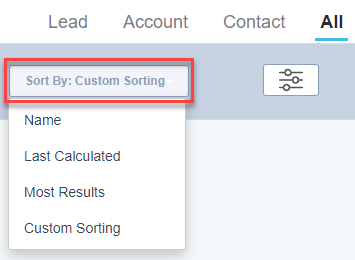
- View Settings: Choose from a variety of view settings to display filters.
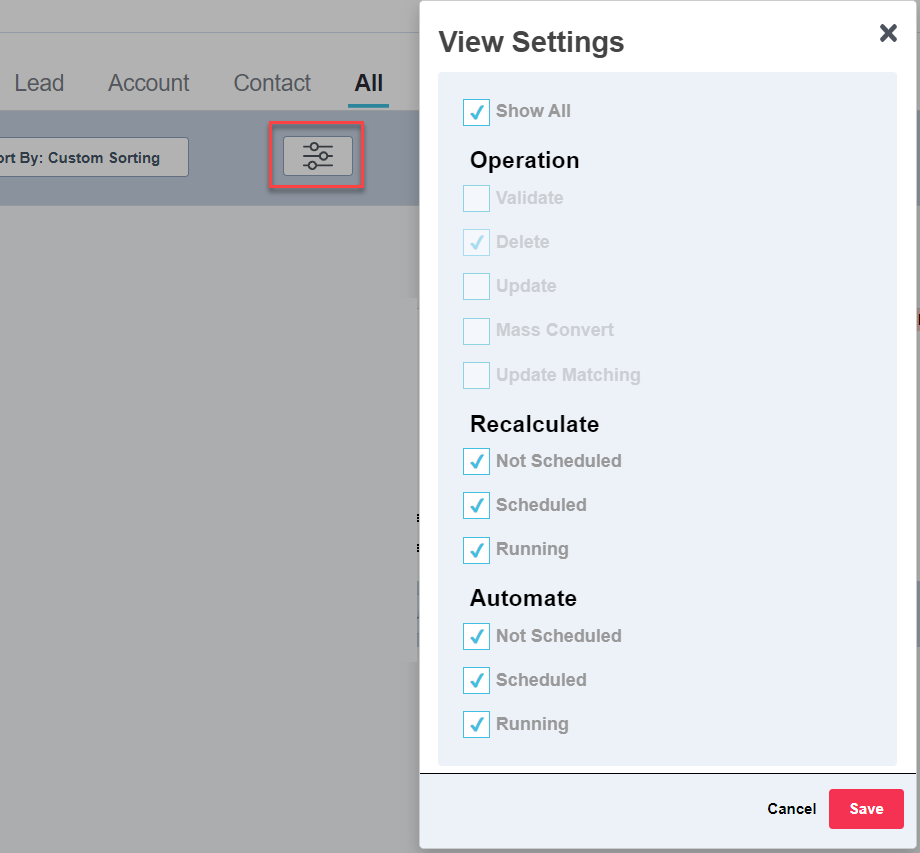
Step 1: The basics
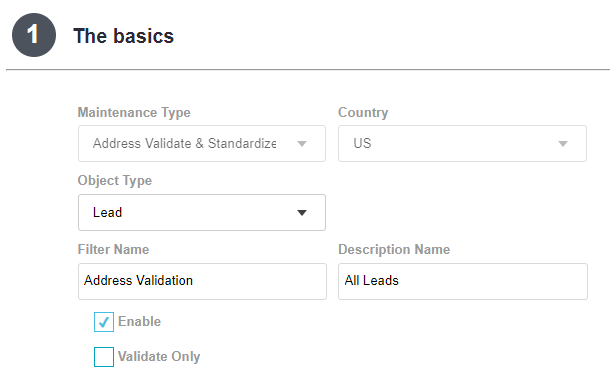
- Maintenance Type: This will automatically default to ‘Address Validate & Standardize’.
- Country: This will automatically default to ‘US’. United States is the only country supported currently.
- Object Type: Choose the object that the updates will be applied to. The list includes any standard or custom object.
- Filter Name: Give the filter a descriptive name.
- Description Name (optional): Give a brief description of the filter.
- Enable: All filters are enabled by default. Disabling makes the filter inactive.
- Validate Only: Choose this option to only run the validation process to determine if the address is valid or not. Standardizing the value to the standard USPS format will not be performed.
Step 2: Which records do you want to update?
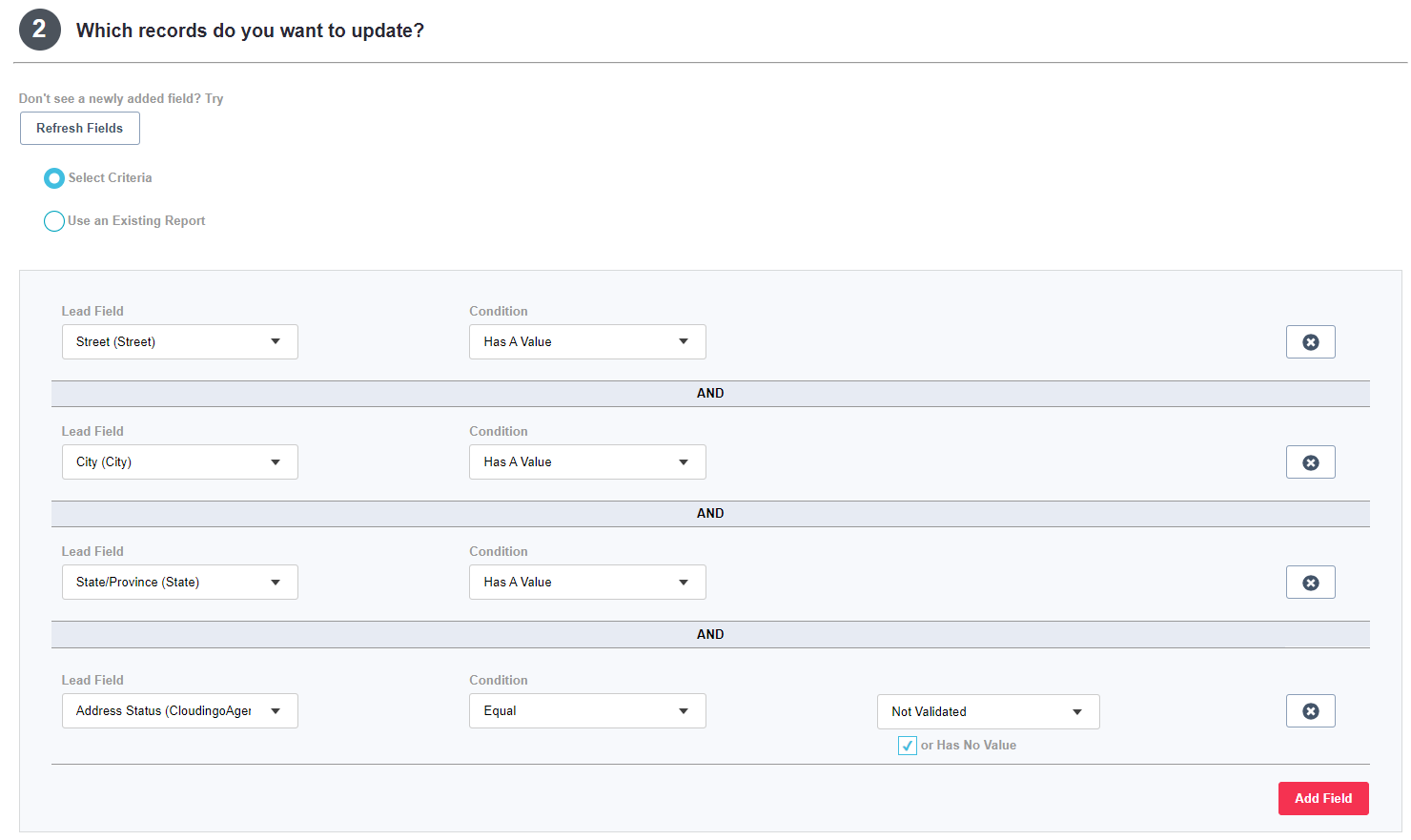
- Select Criteria: Build criteria to filter out records to validate/update.
- Click the ‘Add Field’ button to begin adding fields to the criteria.
- (Object) Field: Choose a field for the criteria to find records.
- Use the ‘Refresh Fields’ option at the top of Step 2 if a field is not showing in the list.
- Use caution when using formula, calculated, or related object fields. Syncs are not sent to Cloudingo when the underlying value is changed. Reindexing may be required. Consider using a Salesforce report instead of building criteria when using these field types.
- Condition: Choose a condition (such as ‘Equal’, ‘Contains’, ‘Has a value’, etc.).
- Specify a value in the far-right blank box if one appears. The condition chosen may require a value but in some cases a value is not required.
- Or Has No Value: Choose this option to also allow records with a blank value for the field to pull into the results.
- Click ‘Add Field’ again to add additional criteria to find records.
- Use an Existing (Salesforce) Report:
- Salesforce reports will appear in the drop box when this option is selected. Choose the desired Salesforce report to pull the list of records to validate/standardize.
- Report must contain the Salesforce Record ID using the standard ID field in the output.
- Report must be accessible to the user establishing the Cloudingo connection.
- Salesforce reports will appear in the drop box when this option is selected. Choose the desired Salesforce report to pull the list of records to validate/standardize.
Filter Recommendations
- Set the filter to pull in records where street has a value, city and/or zip has a value, and state has a value.
- The record must have enough relevant fields populated for validation to occur without failing. Loosen up criteria as necessary later.
- Prevent records that have already processed from pulling into the results repeatedly by setting the job to only pull records where ‘Address Status’ is not equal to ‘valid’, ‘invalid’; or where equal to ‘not validated’, ‘or has no value’.
- Once records are processed, Cloudingo passes the results to the field specified in the mapping stage, and custom address fields may require additional configurations (see Step 3 ‘Field for Cloudingo to update when finished’ below).
- A record’s Address Status is only set to ‘not validated’ when using an add-on tool.
- The add-on tool resets the record as ‘not validated’ after the previously processed address is subsequently updated in Salesforce.
- The add-on tool only works against standard address fields.
- The add-on feature is free for customers and available upon request. Contact the Cloudingo Support Team to obtain the add-on.
Step 3: What fields do you want to update?
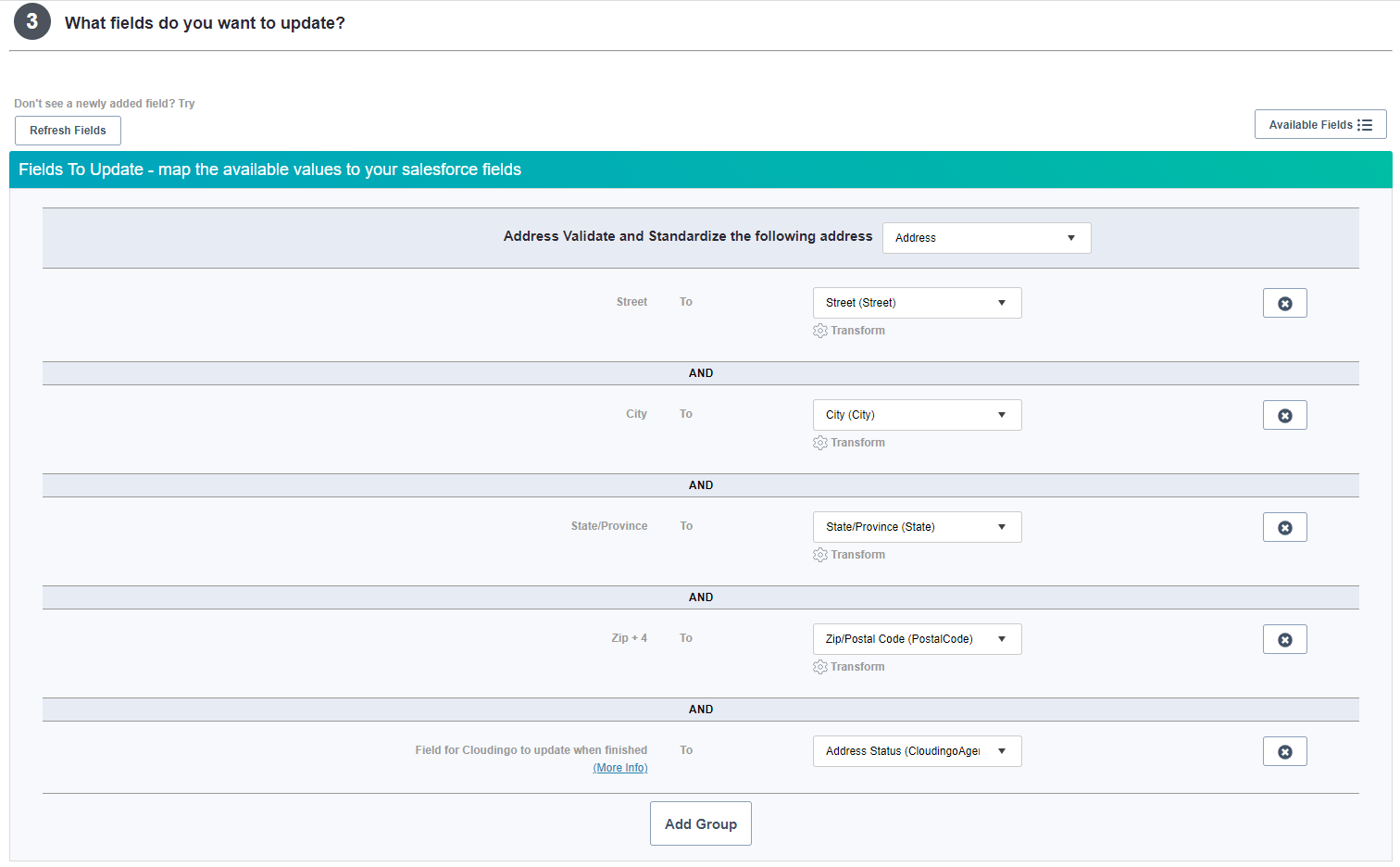
- Address Validate and Standardize the following address: Choose the set of address fields to validate from the top drop-down menu.

- Only standard address fields will appear in the list.
- Cloudingo will auto-map the fields based on the address type chosen.
- Choose custom to map manually (or just map manually in the field mappings page).
- Street: Choose the Salesforce street field to validate.
- City: Choose the Salesforce city field to validate.
- State/Province: Choose the Salesforce state/province field to validate.
- Zip + 4: Choose the Salesforce zip field to validate.
- Field for Cloudingo to update when finished: Choose the Salesforce (numeric type) field to pass the results to when validation is processed.
- Cloudingo comes packaged with a custom field for each standard address. If processing standard address fields, choose the Cloudingo field labeled ‘Address Status’.
- If processing address validation on custom address fields, creating a new field for the Address Status may be required.
- The field must be configured as numeric. ‘1’ will be passed for ‘valid’ and ‘2’ for ‘invalid’.
- Available Fields: Choose to select additional fields to obtain additional address information from the USPS database during the address lookup process.
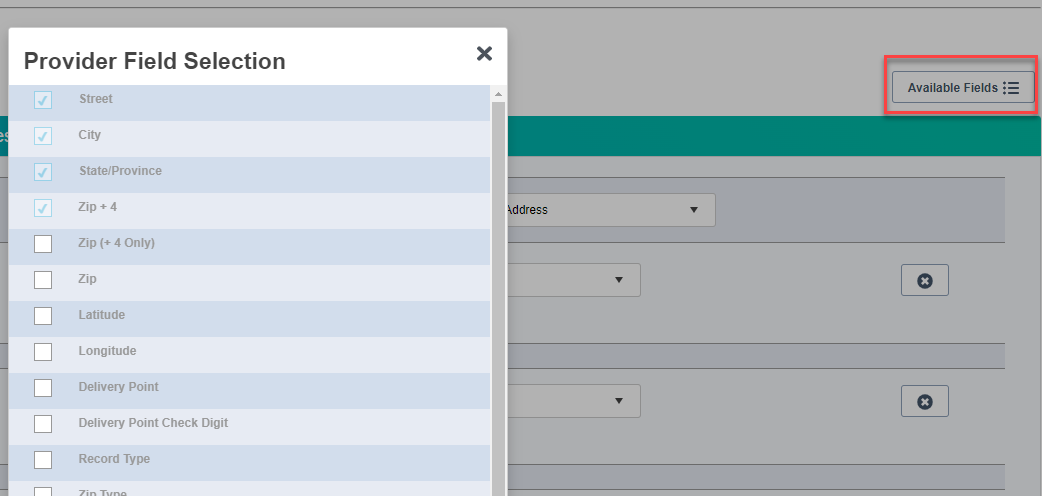
- Examples: County Name, Congressional District, Latitude, Longitude, etc.
- If a field does not exist to store the data once retrieved, create a new custom field for the value, use the ‘Refresh Fields’ option and map to the field accordingly.
- Add Group: Choose to select another group of address fields to validate.
- Repeat steps to map the second set of address fields. Make sure to use unique fields for mapping each set of addresses. Do not re-use fields when mapping two or more different address fields.
- Transform: Choose the Transform option to perform text formatting or state/country conversions (from spelled-out version to code or vice versa).
- Transforms will get applied to the values during standardization of the address.
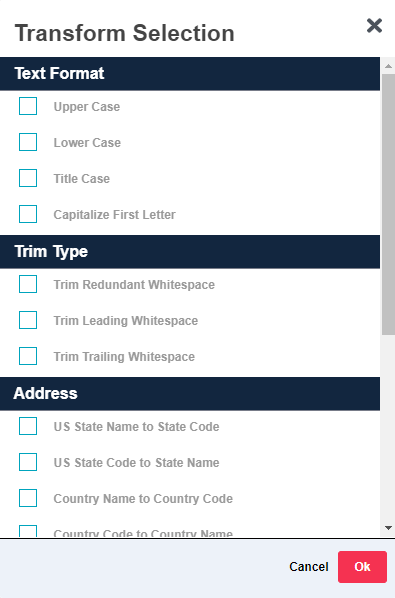
- Transforms will get applied to the values during standardization of the address.
Step 4: What actions do you want to perform? (Optional)
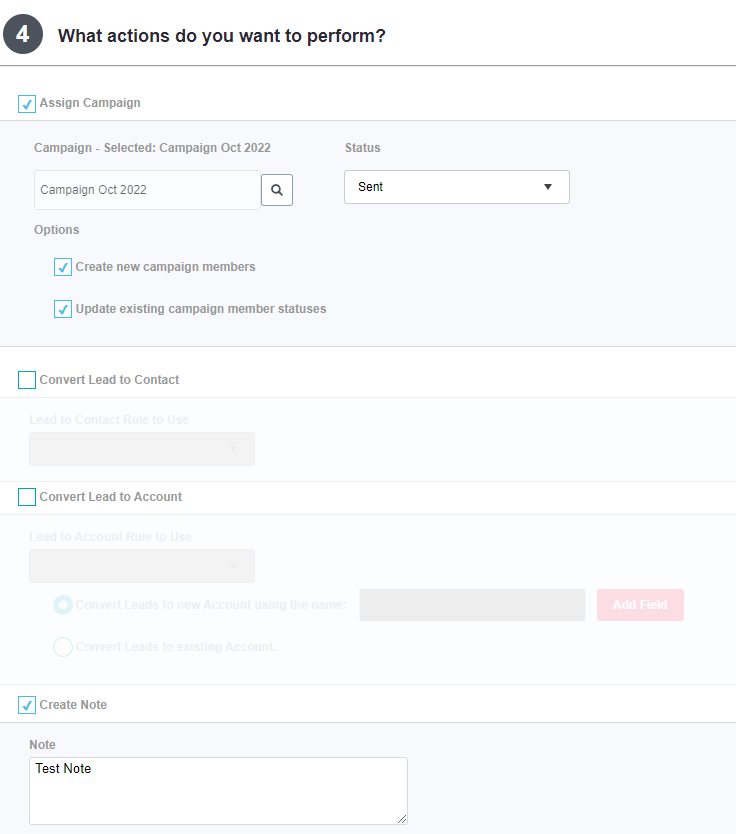
- Assign Campaign: Assign a campaign to all records (Leads or Contacts) in the job while performing the update.
- Choose the ‘Assign Campaign’ option.
- Choose a Campaign in the Campaign box (use search to find a campaign).
- Set a Campaign Status.
- Choose the ‘Create new campaign members’ option to add records in the job to the campaign.
- Choose the ‘Update existing campaign member statuses’ option to update the status of existing campaign members.
- Both options can be enabled simultaneously.
- Convert Lead to Contact: This feature is visible on Lead jobs to accommodate legacy customers with prior configurations. The Mass Convert Leads tool is a newer and easier feature now available to perform updates & conversions simultaneously. Consider using separate jobs. To convert Leads processed through address validation, build the Mass Convert job using the Address Status values.
- Convert Lead to Account/Person Account: This feature is visible on Lead jobs to accommodate legacy customers with prior configurations. The Mass Convert Leads tool is a newer and easier feature now available to perform updates & conversions simultaneously. Consider using separate jobs. To convert Leads processed through address validation, build the Mass Convert job using the Address Status values.
- Create Note: Creates a note under the ‘Notes’ or ‘Notes & Attachments’ section in Salesforce for all records updated. Notes are not searchable in Salesforce and take up space.
Choose ‘Save’ or ‘Save & Run’ (to query for results) to save the filter configuration.
Re-indexing
When creating or editing a filter with new fields (on indexed objects), Cloudingo initiates a re-indexing process on the object that may take time. To avoid this, users can pre-set a list of fields they will be using in their filters by going to 'Account' → 'Settings' → 'Manage Objects' from the top right toolbar.
Preview Results
Make sure to preview the filter results for accuracy before performing updates. Check to ensure that the correct records are pulling in and the correct values will be applied.
Tokens will be used for each record viewed.
- Choose the ‘View Results’ option on the filter after the filter has been calculated.
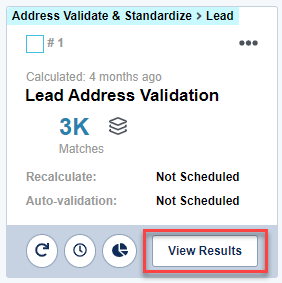
- Choose the red arrow on a group to preview the results. Check a few records for accuracy.

- Update the records viewed manually using the update option at the bottom of the page since the token is already being used to view results.
- Update the records viewed manually using the update option at the bottom of the page since the token is already being used to view results.
- The preview will display the current record on the left and the values to be updated on the right.
- If standardizing, the USPS standard format will be displayed.

- If standardizing, the USPS standard format will be displayed.
Validate/Standardize
After checking records for accuracy, run the validation/standardization process. There are three ways to validate/standardize.
- Manually: Update one record at a time from the preview page.

- Update: Updates the record and returns the view back to the record list.
- Update & Load Next: Updates the record and immediately opens the next record.
- Skip & Load Next: Loads the next record without updating the current record.
- Mass Update: Update records one page at a time from the preview page.

- Select records using the checkboxto the left to be updated.
- Or choose the Select All box at the top left corner.
- Choose the ‘Mass Address Validate & Standardize’ button at the top of the record list to submit all selected records in view.
- Page through results using the page numbers at the bottom of the results list.
- Mass Updates can only be done one page at a time.
- Watch the Activity Stream for the update confirmation back from Salesforce to see if updates were successful or a failure (or view the Activity Stream Error/Warnings report from the Reports dashboard to get a list of failures).
- Results within the pages will refresh in the list as records are updated and when moving through the pages.
- Select records using the checkboxto the left to be updated.
- Automation: Update all records in the filter by starting a one-time automation job or schedule to run the job repeatedly.
- For a one-time job:
- From the filter’s menu option, choose ‘Start Automation’ or choose the ‘Automation’ menu option from within the preview page and choose ‘Start Automation’.
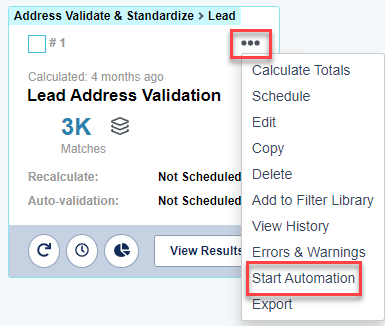
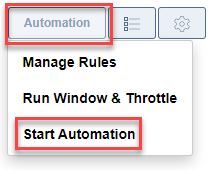
- Choose ‘Automate’ on the confirmation page.
- Check the Run Window & Throttle settings if the job does not start within a reasonable time.
- Check the Run Window & Throttle settings if the job does not start within a reasonable time.
- From the filter’s menu option, choose ‘Start Automation’ or choose the ‘Automation’ menu option from within the preview page and choose ‘Start Automation’.
- To schedule the job to run repeatedly:
- From the filter’s menu option, choose ‘Schedule’.
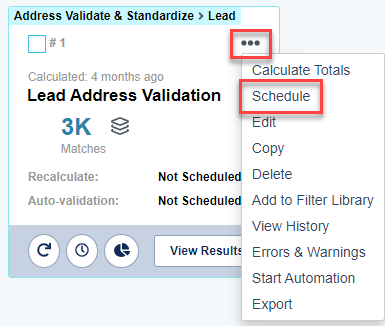
- Toggle the dot to the right to enable the ‘Schedule recalculation’.

- Specify a frequency (one time, hourly, daily, or weekly. Set any additional settings related to the frequency as required.
- Specify a start date and start time.
- The ‘Keep Schedule Running’ option must be enabled for the job to continue processing at the scheduled time.
- Toggle the dot to the right to enable ‘Schedule auto – validation’ to process the job and 'Save'. If disabled, the job will only perform the calculation (query) at the scheduled time.
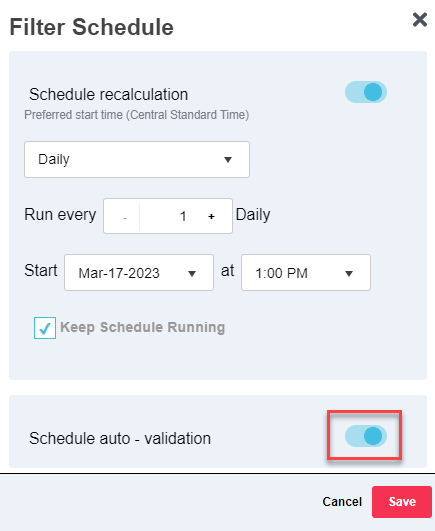
- From the filter’s menu option, choose ‘Schedule’.
- For a one-time job:
.png)

